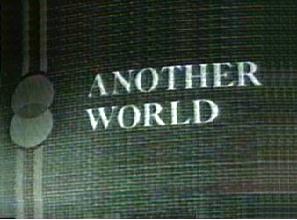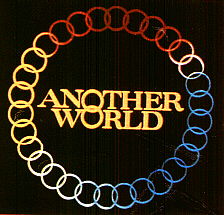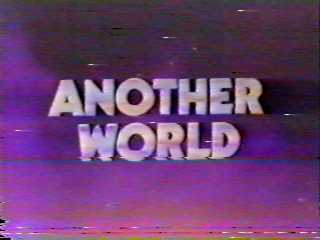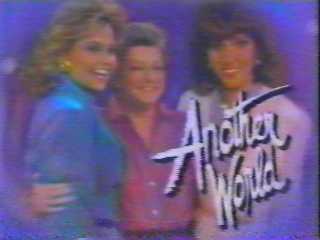ANOTHER WORLD
AND ITS SPIN-OFFS
It started out being a spin-off from CBS' As the World Turns, but had to move to another network when CBS had no room for it on its schedule. The resulting show, Another World, would become one of the most popular and innovative soaps of all time. It was one of the first soaps to switch from black and white to color. It was also the first soap to go from a half-hour to an hour, the first (and only) daily soap to expand to 90 minutes, and the first soap to spawn daytime soap spin-offs.
Since Eddie Drueding goes into great detail in describing AW's openings on his Another World Home Page, I'm not going to go into quite as much detail. Instead, I'll try to give proper theme song credit and try to add some logotype trivia.
The Early Years--1964 to 1966
 Early
episodes of Another World opened with the following epigram:
Early
episodes of Another World opened with the following epigram:
We do not live in this world alone, but in a thousand different worlds.
The title of the show is set in the Century Schoolbook bold typeface.
Another World in Living Color--1966 to 1974
 A
new opening sequence debuted when Another World went from black and
white to color in June 1966. This new opening marked the first appearance of
AW's most beloved logo, the wreath of interlocking circles. The lettering for
the new opening was set in the Craw Modern typeface, which would also be used
for the early Somerset logo. The visual consisted of a literal blooming
of multicolored circles as they slowly came together into one wreath of
interlocking circles.
A
new opening sequence debuted when Another World went from black and
white to color in June 1966. This new opening marked the first appearance of
AW's most beloved logo, the wreath of interlocking circles. The lettering for
the new opening was set in the Craw Modern typeface, which would also be used
for the early Somerset logo. The visual consisted of a literal blooming
of multicolored circles as they slowly came together into one wreath of
interlocking circles.
This sequence accompanied two different theme songs: the original theme by Charles Paul, and the mid-to-late 1970s theme by Bob Israel and Arthur B. Rubinstein.
The organ rendition of the Charles Paul theme was used until probably the fall of 1973, and the recorded full orchestra version was used until at least September 1974.
Another World's Golden Age--1974 to 1981
Since there are few surviving tapes of Another World episodes from the 1974/75 season, it is difficult to verify exactly when the Israel/Rubinstein AW theme debuted. However, I've had e-mail correspondence with one Another World fan who remembers that the Israel/Rubinstein theme was being used before the first regularly scheduled one hour episode of January 6, 1975. Based on this information, I must conclude that the Israel/Rubinstein theme debuted no earlier than late-September 1974 and no later than January 6, 1975.
A Period of Transition--1981 to 1987
By no later than October 5, 1981, Another World unveiled a brand new opening sequence, which used some computer-generated techniques similar to those of the Superman movies starring Christopher Reeve.
 In
the new opening, the familiar wreath of interlocking circles zooms toward us in
a wash of silvery light. (This effect was created by a streak timing effect
similar to that used in the Superman movie main titles.) This is
followed by a light-outlined silhouette of a man and a woman kissing. Then the
title of the show appears in chrome metallic Kabel Ultra Heavy type.
In
the new opening, the familiar wreath of interlocking circles zooms toward us in
a wash of silvery light. (This effect was created by a streak timing effect
similar to that used in the Superman movie main titles.) This is
followed by a light-outlined silhouette of a man and a woman kissing. Then the
title of the show appears in chrome metallic Kabel Ultra Heavy type.
There is some conflicting information about the start date of this opening. A fan recently wrote in a message board post that he remembers this opening debuting on Labor Day (September 7) of 1981.
1987 to 1996
 The
theme song that would go with this "Paint Box" created opening
premiered on Friday, March 27, 1987 via a guest appearance by singers Crystal
Gayle and Gary Morris. An instrumental version of the new theme, "(You
Take Me Away To) Another World," was used with the 1981 visual opening
until late October 1987. At the end of October 1987, the new visual sequence
debuted. It consisted of computer enhanced visuals of each cast member. And an
electronic graphics device known as a "Paint Box" gives each visual
clip the look of a simulated watercolor painting. Such an effect was previously
used in the main titles for NBC's Saturday Night Live.
The
theme song that would go with this "Paint Box" created opening
premiered on Friday, March 27, 1987 via a guest appearance by singers Crystal
Gayle and Gary Morris. An instrumental version of the new theme, "(You
Take Me Away To) Another World," was used with the 1981 visual opening
until late October 1987. At the end of October 1987, the new visual sequence
debuted. It consisted of computer enhanced visuals of each cast member. And an
electronic graphics device known as a "Paint Box" gives each visual
clip the look of a simulated watercolor painting. Such an effect was previously
used in the main titles for NBC's Saturday Night Live.
The Final Years: The Melrose Place Look Comes to Bay City
As
part of a wholesale shake-up at all the Procter & Gamble soaps in 1995,
Jill Farren Phelps, the award-winning executive producer of Santa Barbara
and Guiding Light, took over the top spot at Another World. On
March 4, 1996, Ms. Phelps introduced an opening which shared several things in
common with Melrose Place and ER and which would take Another
World through its final three years on the air.
The long-gone wreath of interlocking circles has been replaced by a recurring shot of a spinning gyroscope. Throughout the main title, there are fast-cutting black and white, sepia-toned and color visuals of character poses, sensual love scenes, and people walking up and down the streets. Many of the visuals highlight Bay City's youth scene. There is even an ER/Melrose Place style monogrammed "aw" logo.
Here is a list of the theme songs used by Another World:
- Theme #1: "Another
World Theme"
Composer: Charles Paul.
Copyright: April 27, 1964 (Eu 822925)
Dates of Usage: May 4, 1964 to no later than January 3, 1975
Published Sheet Music:
Recordings: - LP: "Original
Themes from the Great Soap Operas"
Charles Paul
Realm Records (A division of Columbia House) 2V-8056 (1977) - Theme #2: "Another
World Theme"
BMI Work # 2195414
Composer: Robert A. Israel (BMI)
Publisher: Flatbush Music Co. (Score Productions)
Copyright Date: February 17, 1977 (EU 773437)
Approximate Usage Dates: This theme debuted, at the earliest, in late September of 1974 and was used over the opening and closing of the show until, at the latest, October 2, 1981.
Published Sheet Music:
Recordings: - LP: "Great Love
Themes from Daytime Television"
D'Arneill Pershing and the London Studio Orchestra
(Nova LPS-00001) 1978 - LP: "Soap Opera
Favorites"
D'Arneill Pershing
(Sine Qua Non SQN-5053)
This is a 1986 US release of an album originally issued in Great Britain. - LP: "The Great
Soap Opera Themes"
New Christy Minstrels
Capitol SL-8076/Springboard TVP-1011 - Theme #3: "Another
World"
Composer(s): Bob Israel and/or Jonathan L. Segal
Publisher:
Copyright:
Dates of Usage: September 7, 1981 to March 27, 1987
Published Sheet Music:
Recordings: - "Your Favorite
Soap Opera Themes"
MMR Productions MMRP-2200 (1986) - Theme #4: "(You Take
Me Away to) Another World"
Composers: John Leffler and Ralph Schuckett
Copyright: 1987 (Pau-975-529)
Publisher: Fountain Square Music (ASCAP)
Published Sheet Music:
Recordings: - Theme #5: "Another
World Theme"
BMI Work #2195415
Composer: Dominic Messinger (BMI)
Publisher: Riverfront Music Publishing Co.
Published Sheet Music:
Recordings:
There are very comprehensive descriptions of Another World's openings over the years on the Another World Home Page website. Check it out at this address: http://www.igs.net/~awhp.
You also may want to visit swissJohn's Another World Tribute page at http://awtribute.topcities.com.